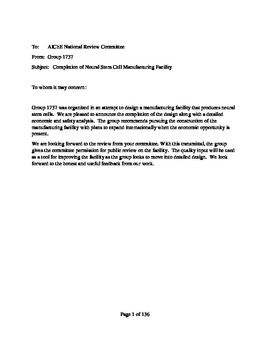| dc.contributor.author | Dadgar, Andishaeh | |
| dc.date.accessioned | 2017-10-10T20:54:15Z | |
| dc.date.available | 2017-10-10T20:54:15Z | |
| dc.date.issued | 2016-03-09 | |
| dc.identifier | oksd_dadgar_HT_2016 | |
| dc.identifier.uri | https://hdl.handle.net/11244/52255 | |
| dc.description.abstract | Over the past ten years, advances in stem cell therapy have progressed from low yield treatments on small organisms, to effective, targeted treatments on humans. One of the largest markets for stem cell therapy is treatment of bodily injury, particularly in the nervous system. Research has shown that induced pluripotent stem cells can expand and differentiate into neural stem cells, which has been clinically shown to relieve pain caused by spinal cord injuries. Currently, over 250,000 Americans suffer from spinal cord injuries, with a 5% increase predicted over the next five years. Stem cell therapy is a rapidly developing field to provide treatment of these injuries, and with the technology available, a facility can be designed to produce enough neural stem cells to treat the entire market. | |
| dc.description.abstract | Specifically, induced pluripotent stem cells have shown to grow rapidly with relatively high viability in vitro. By selectively differentiating induced pluripotent stem cells into neural stem cells, a large amount of neural stem cells can be provided to victims of spinal cord injury. The facility outlined in this report is designed to take a batch of 100,000 induced pluripotent stem cells and create enough neural stem cells to treat the predicted American population over the next five years. The total amount of neural stem cells needed to treat the entire market is approximately 1.2 trillion cells per year. Batch processes, especially pharmaceutical processes, have relatively low service factors. A service factor of 0.75 was determine in order to account for the significant down time associated with batch processes because sterilization is key to maintaining the integrity of the facility and product. | |
| dc.description.abstract | Economically, the viability of the project has been evaluated over a 5 year time period with a minimum rate of return of 50%. It is very likely that international expansion will present an economic opportunity in a relatively short time frame. To account for potential expansion, the facility has the ability to incorporate overseas markets when the opportunity arises. It is recommended that the company moves forward with detailed design of the facility immediately to capitalize on the current financial opportunity. | |
| dc.format | application/pdf | |
| dc.language | en_US | |
| dc.rights | Copyright is held by the author who has granted the Oklahoma State University Library the non-exclusive right to share this material in its institutional repository. Contact Digital Library Services at lib-dls@okstate.edu or 405-744-9161 for the permission policy on the use, reproduction or distribution of this material. | |
| dc.title | Design for neural stem cell commercial manufacturing facility | |
| osu.filename | oksd_dadgar_HT_2016.pdf | |
| osu.accesstype | Open Access | |
| dc.type.genre | Honors Thesis | |
| dc.type.material | Text | |
| thesis.degree.discipline | Chemical Engineering | |
| thesis.degree.grantor | Oklahoma State University | |
